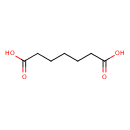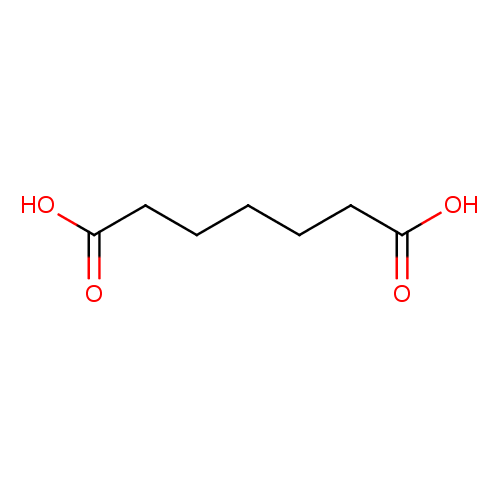|
Record Information |
|---|
| Version |
1.0 |
|---|
| Update Date |
1/22/2018 11:54:54 AM |
|---|
|
Metabolite ID | PAMDB110023 |
|---|
|
Identification |
|---|
| Name: |
pimelate |
|---|
| Description: | A dicarboxylic acid dianion obtained by the deprotonation of both the carboxy groups of pimelic acid. |
|---|
|
Structure |
|
|---|
| Synonyms: | -
heptanedioate
-
6-carboxyhexanoate
-
pimelic acid
|
|---|
|
Chemical Formula: |
C7H10O4
|
|---|
| Average Molecular Weight: |
158.15 |
|---|
| Monoisotopic Molecular
Weight: |
160.0735588736 |
|---|
| InChI Key: |
WLJVNTCWHIRURA-UHFFFAOYSA-L |
|---|
| InChI: |
InChI=1S/C7H12O4/c8-6(9)4-2-1-3-5-7(10)11/h1-5H2,(H,8,9)(H,10,11)/p-2 |
|---|
| CAS
number: |
111-16-0 |
|---|
| IUPAC Name: | heptanedioate |
|---|
|
Traditional IUPAC Name: |
pimelic acid |
|---|
| SMILES: | C([O-])(=O)CCCCCC([O-])=O |
|---|
|
Chemical Taxonomy |
|---|
|
Taxonomy Description | This compound belongs to the class of organic compounds known as medium-chain fatty acids. These are fatty acids with an aliphatic tail that contains between 4 and 12 carbon atoms. |
|---|
|
Kingdom |
Organic compounds |
|---|
| Super Class | Lipids and lipid-like molecules |
|---|
|
Class |
Fatty Acyls |
|---|
| Sub Class | Fatty acids and conjugates |
|---|
|
Direct Parent |
Medium-chain fatty acids |
|---|
| Alternative Parents |
|
|---|
| Substituents |
- Medium-chain fatty acid
- Dicarboxylic acid or derivatives
- Carboxylic acid
- Carboxylic acid derivative
- Organic oxygen compound
- Organic oxide
- Hydrocarbon derivative
- Organooxygen compound
- Carbonyl group
- Aliphatic acyclic compound
|
|---|
| Molecular Framework |
Aliphatic acyclic compounds |
|---|
| External Descriptors |
|
|---|
|
Physical Properties |
|---|
| State: |
Solid |
|---|
| Charge: | -2 |
|---|
|
Melting point: |
103 - 106 °C |
|---|
| Experimental Properties: |
| Property | Value | Reference |
|---|
| Melting Point | 103 - 106 °C | Not Available | | Boiling Point | Not Available | Not Available | | Water Solubility | 50.0 mg/mL | Not Available | | LogP | 0.61 | HANSCH,C ET AL. (1995) |
|
|---|
| Predicted Properties |
|
|---|
|
Biological Properties |
|---|
| Cellular Locations: |
Not Available |
|---|
| Reactions: | |
|---|
|
Pathways: |
Not Available |
|---|
|
Spectra |
|---|
| Spectra: |
| Spectrum Type | Description | Splash Key | |
|---|
| GC-MS | GC-MS Spectrum - GC-EI-TOF (Pegasus III TOF-MS system, Leco; GC 6890, Agilent Technologies) | splash10-056s-1910000000-58bf29a41b2e4b405df9 | View in MoNA |
|---|
| LC-MS/MS | LC-MS/MS Spectrum - Quattro_QQQ 10V, Negative (Annotated) | splash10-0002-9300000000-a3d2b3924fcede41e331 | View in MoNA |
|---|
| LC-MS/MS | LC-MS/MS Spectrum - Quattro_QQQ 25V, Negative (Annotated) | splash10-0002-9100000000-7050dc1518d598ad5051 | View in MoNA |
|---|
| LC-MS/MS | LC-MS/MS Spectrum - Quattro_QQQ 40V, Negative (Annotated) | splash10-052e-9200000000-84550d0cfeb05e8d79bd | View in MoNA |
|---|
| LC-MS/MS | LC-MS/MS Spectrum - EI-B (Unknown) , Positive | splash10-0r7l-9100000000-b698134a5d1e523a961e | View in MoNA |
|---|
| LC-MS/MS | LC-MS/MS Spectrum - LC-ESI-QQ (API3000, Applied Biosystems) 10V, Negative | splash10-0a4i-0900000000-a3b877a40a98e4d07993 | View in MoNA |
|---|
| LC-MS/MS | LC-MS/MS Spectrum - LC-ESI-QQ (API3000, Applied Biosystems) 20V, Negative | splash10-0002-9500000000-6f90176eaadac29eae28 | View in MoNA |
|---|
| LC-MS/MS | LC-MS/MS Spectrum - LC-ESI-QQ (API3000, Applied Biosystems) 30V, Negative | splash10-0002-9000000000-859f1028218d04c20dc6 | View in MoNA |
|---|
| LC-MS/MS | LC-MS/MS Spectrum - LC-ESI-QQ (API3000, Applied Biosystems) 40V, Negative | splash10-0002-9000000000-ef436118494b323530f4 | View in MoNA |
|---|
| LC-MS/MS | LC-MS/MS Spectrum - LC-ESI-QQ (API3000, Applied Biosystems) 50V, Negative | splash10-0002-9000000000-15fa4059d8c10e1e3a03 | View in MoNA |
|---|
| 1D NMR | 1H NMR Spectrum | Not Available |
|---|
| 2D NMR | [1H,13C] 2D NMR Spectrum | Not Available |
|---|
|
|---|
|
References |
|---|
| References: |
- Guneral F, Bachmann C: Age-related reference values for urinary organic acids in a healthy Turkish pediatric population. Clin Chem. 1994 Jun;40(6):862-6. [8087979 ]
- Passi S, Picardo M, Mingrone G, Breathnach AS, Nazzaro-Porro M: Azelaic acid--biochemistry and metabolism. Acta Derm Venereol Suppl (Stockh). 1989;143:8-13. [2505463 ]
- Pettit BR: The analysis of thiodiglycollic acid by selected ion monitoring. Clin Chim Acta. 1986 Apr 15;156(1):85-90. [3698320 ]
- Niwa T, Ohki T, Maeda K, Saito A, Kobayashi K: Pattern of aliphatic dicarboxylic acids in uremic serum including a new organic acid, 2,4-dimethyladipic acid. Clin Chim Acta. 1979 Nov 15;99(1):71-83. [498544 ]
- Mahadevappa VG, Holub BJ: The molecular species composition of individual diacyl phospholipids in human platelets. Biochim Biophys Acta. 1982 Oct 14;713(1):73-9. [7138900 ]
|
|---|
| Synthesis Reference: |
Murib, Jawad H.; Kahn, John H. Production of pimelic acid by carbonylation of e-caprolactone using excess water. U.S. (1989), 3 pp. |
|---|
| Material Safety Data Sheet (MSDS) |
Download (PDF) |
|---|
|
Links |
|---|
| External Links: |
|
|---|


